#anti-Francoist
Explore tagged Tumblr posts
Text
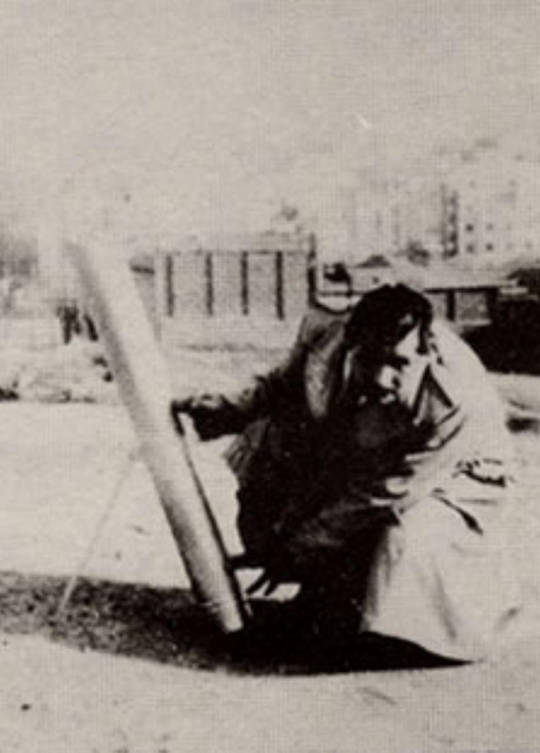
Anarchist anti-Francoist guerrilla Quico Sabaté firing a mortar loaded with propaganda leaflets over Barcelona in 1955.
#anarchism#anarchist#class war#history#anti-Francoist#guerrilla#Quico Sabaté#barcelona#barcelona spain#spain#161#1312#anti capitalism#antifascist#antiauthoritarian#antinazi#eat the rich#eat the fucking rich#anti imperialism#anti colonialism#anti cop#anti colonization#antifaschistische aktion#ausgov#politas#auspol#tasgov#taspol#australia#fuck neoliberals
8 notes
·
View notes
Text
"We know that currently in our context it is not easy to always act according to anarchist practice. But it should not be too much to ask for a minimum coherence between the actions we choose to follow and maintain the anarchist principles of struggle against capitalism and all its state and corporate institutions, not only on paper but also in the strategies of struggle. Organisations (like people) are what they do and not what they say they are. In the same way that, at least some of us, reflect on whether this or that thing we do is anarchist, this parameter of coherence should also be used to look at organisations.
(...)
Here it is clear to everyone that the de facto position of the CNT-CIT to involve in a conflict with another anarchist union the state judicial system, which in the case of Spain is a post-Francoist system, already directly invalidates their position as anarchists. This break with facts, which are on top of having contact with police forces and transphobic groups previously, should drop the false mask of the CNT-CIT for good and simply be expelled from any international confederation that advocates anarchist principles. At this historical moment we cannot let such undeniable and destructive inconsistencies pass, and therefore from now on people should no longer in any way think of the CNT-CIT as an anarcho-syndicalist group.
At the same time it is interesting to see how the CNT-AIT compañeras allow themselves to be involved in the state judicial system in order to defend themselves. Long gone are the days when anarcho-syndicalists flatly refused to recognise and accept not only the existence of the state judiciary, but actively participate in it. We think that in this case we should return to the practice of sabotage. Don't show up at the trials, don't obey the judgement, let alone be present in this capitalist circus we are living through. We know that the consequences of such a sabotage can be very serious, and at the same time we must think about the long-term signals we are giving.
(...)
We know that the consequences of not legitimising the process, the Audiencia Nacional or the fine can be serious. But here the third question arises: why is it not raised and made public that the process is not given validity and that nothing will be paid?
The consequences of attending the trial, of falling into this legal game is not only to endorse the action of CNT-CIT and endorse the court, it is to abandon the usual anarchist practices of sabotage and refusal to abide by the decisions of the state powers in similar situations. And this, to be fair, is not something only the CNT-AIT should be questioned for, it is a general tendency of all anarcho-syndicalists and part of the anarchist movement. The response to the conflict generated by the CNT-CIT from a neoliberal perspective is framed in a context of anarchist methods and proposals falling into oblivion in a serious international situation of ecocide, the rise of fascism and racism, transphobia, ableism, homophobia and machismo, as well as brutal neoliberalisation and normalisation of genocides. Are we willing to completely abandon our anarchist red lines that unite our principles, our ethics and our tools? So why do we talk about anarchism or that we carry a new world in our hearts when we do not build it by defending our principles with deeds?
(...)
A very concrete point of the CNT-CIT's denunciation of the CNT-AIT is to be able to own the buildings of the CNT-AIT headquarters. It would not be necessary to point out the contradiction of having a dispute over private property, since anyone with a minimal anti-capitalist perspective knows that private property is the main expression of everything we have been fighting against for centuries.
This denunciation is one of the points that have also remained without a forceful response, reflecting and publicly stating, not only from the CNT-AIT, but from international anarchist movements, that regardless of the ruling of the national court, the headquarters will be occupied if they are taken by state and police force. The question on this issue, then, is why we are waiting for an institutional body that we don't even believe in and that we actually want to abolish, to make a decision on this issue. Whatever happens at the Audiencia Nacional, we encourage the occupation, not only of the CNT-AIT headquarters, but all the places that are needed to be able to rebuild our movements and our anarchist unions.
If we take a historical look at anarchist movements, are physical spaces such a trigger for our struggles that they must be defended as private property? Anarchist struggles take place in whatever space is necessary, without the need to have them institutionally approved. We are aware that occupations have been persecuted by the media in recent years by demonising them. Part of the neoliberal propaganda is precisely to delegitimise certain collective practices in favour of so-called legal practices. This should not permeate within anarchist movements, rather we should continue to struggle and and organise popular education so that people understand that being able to have autonomous and free places to live, to organise, to meet and to maintain our communities is a right.
Do so many people really think that if the CNT-AIT is left without its heritage, anarcho-syndicalism would be lost? It is the people practising our anarchist principles and ideals who build and defend anarchist movements, not the walls, doors or furniture of a building. It would be important to rethink whether, apart from the pain of the loss of a historical testimony such as a headquarters building, anarchist struggles go far beyond private material properties which in reality are an invention of capitalism."
-Sonia Muñoz Llort and Mireia Redondo Prat, "Fire to the anarchist unions: chronicles of a death foretold" (October 25, 2024)
21 notes
·
View notes
Note
Was curious if you have any interesting information on L’Hospitalet de Llobregat?
I moved about a year ago, and I am about to sign up for my first Catalan class with the CNL soon. Since I do not speak Catalan yet and have limited Spanish, a lot of information I come across for my new home is not accessible to me.
Thank you in advance, and for you write on here in general. It is a great resource.
Thank you! And best wishes for the course with CNL, I hope you enjoy it!
L'Hospitalet de Llobregat is the 2nd most populated city in Catalonia and has the most densely-populated neighbourhood in all of Europe (Torrassa and Collblanc neighbourhoods). I'll shorten it to L'H from now on.
There's archaeological evidence of population in what nowadays in L'H since the Paleolithic (hunter-gatherer communities in the Prehistory), Ancient Iberian (the indigenous people who lived here before the Roman invasion), and the Roman era.

Ancient Roman head of Medusa known as "Medusa de Provençana", found in an excavation next to the Santa Eulàlia de Provençana church in L'H. Nowadays it's exhibited in the Museu d'Arqueologia de Catalunya, Barcelona.
The origin of the city as we know it now dates back to the Middle Ages. It originated as two entities: the older Provençana (which we have written records of since around the year 900, and was found around Sta Eulàlia de Provençana) and the later Hospital de la Torre Blanca ("Hospital of the White Tower", from around the year 1100, what is now barri del Centre). The second one was a hospital not in our modern sense of a place to take care of the ill, it was a house for helping poor and homeless people, probably founded by the Knights Hospitaller. It grew in population and ended up becoming more important than Provençana, and eventually the name that designated the whole area was changed from Provençana to L'Hospitalet (meaning "The Little Hospital" in Catalan).
But throughout all of these centuries, L'H was a very rural town with a small population (as an example, it had about 900 inhabitants in the year 1815). The population grew when an irrigation canal was built that allowed the fields to be way more productive, reaching 5,000 inhabitants around the year 1900. But the population boom came in the 1960s and 1970s, during the Francoist dictatorship, when many immigrants from different rural parts of Spain moved to the big cities to work in the industry. That's when the areas around Barcelona were quickly built up in these massive apartment blocks to make the "bedroom cities" from where the newly-arrived workers commuted to work every day. The population boom was so huge that it explains why L'H is the 2nd biggest city in Catalonia and so densely populated.
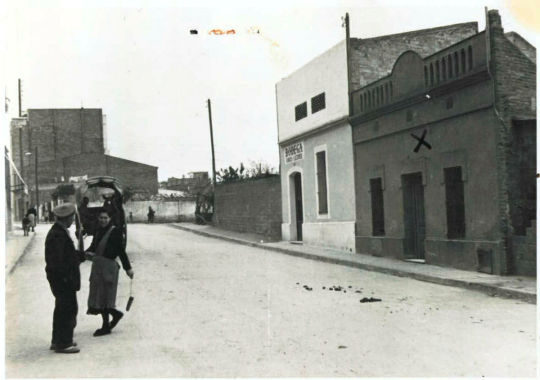

Carrer de la Florida in 1956 vs 2024. (L'H city archive / Google Maps).


Carrer de la Renclusa, 84, in 1955 vs 2024. (L'H city archive / Google Maps).


Carrer de la Mina, 19, in 1956 vs 2024. (L'H city archive / Google Maps).


Avinguda del Torrent, 78, in 1956 vs 2024. (L'H city archive / Google Maps).
These "bedroom cities" had been built so quickly, that they didn't have any services. The inhabitants had to fight for all the services they have, which created a strong sense of pride that still continues nowadays.
As another note, one of the most famous maquis (anti-Francoism guerrilla fighters) was from L'H: Quico Sabaté. You can read about him on Wikipedia here. Another famous person from L'H is Ferran Adrià, one of the most famous chefs in the whole world.
I hope this was interesting, and I hope you can make the most of the Catalan classes, it will surely help you understand the country more and get better perspectives for a job.
22 notes
·
View notes
Text
Does anyone know if there is evidence other than the claims of a South African Nazi who claims to have them for the idea that Tolkien was a lifelong subscriber to Candour, the anti-Semitic newspaper and organ of the League of Empire Loyalists? The one that is known is that he subscribed to the Blackshirt during the Spanish Civil War and was a passionate Franco-supporter (and I wouldn't be surprised if he remained a Francoist after the war), but he stopped after the Spanish Civil War and was opposed to Nazism and (at least) radical and racial anti-Semitism. This is known and there is a lot of evidence for it.
As for Candour however I've only heard this south African Nazi claim it - but if he were to support any political tendency to the right of Tories in his lifetime it'd be Chesterton's League, so in a way it wouldn't surprise me.
15 notes
·
View notes
Text



Tras el cristal 1986, Agustí Villaronga
[...] The story suggests the “changing of the guard” where the student takes over from the master. In this respect the film is reminiscent of the Stephen King novella “Apt Pupil,” adapted to the screen in 1998 by Bryan Singer, in which an adolescent discovers that an old man living in his neighborhood is a Nazi war criminal, and, rather than expose him, blackmails him into recounting his Nazi crimes in all their vivid detail.
[...] A second possible reading elaborates on the first by adding a reflexive element centered on the act of watching. In such films the act of murder is in one or several ways aligned with the pleasure of watching, scopophilia (pleasure in the act of voyeurism), and is directly inscribed in the text. [...] The third possible source of meaning in the film is figurative rather than literal, and involves placing it within the context of Spain’s social-cultural-political history. [...] During the Francoist era, the depiction of violence was repressed, as was the depiction of sex, sacrilege, and politics; this repression helps explain why eroticized violence could be used so effectively by the anti-Francoist opposition to speak a political discourse, that is, to expose the legacy of brutality and torture that lay hidden behind the surface beauty of the Fascist and neo-Catholic aesthetics. (Kinder, p. 138). [...] full
#Tras el cristal#spanish film#in a glass cage#movies#cinema#film#Agustí Villaronga#David Sust#Gisèle Echevarría#Günter Meisner#Marisa Paredes#Gilles de Rais#Jaume Peracaula#post mankind
8 notes
·
View notes
Note
Could you please explain what the Real Madrid / Barca situation is? I see everyone commenting on it but not saying what happened.
OK I'm really not an expert so anybody please correct me on anything but basically laporta (Barcelona president) accused Madrid of being the regime's club, ie the fascist Francoist regime. This is a point of huge debate and while Franco did say madrid was his favourite club there isn't really any [conclusive] evidence that they particulaly benefited from Franco [edit: this is a little too conclusive a summing up for what is an incredibly convuluted and debated topic of which there isn't an easy conclusive answer. This tifo video goes into a bit more detail.] and like everyone else they experienced their fair share of suffering. Laporta was very wrong to say this. It uses an awful period of history to try and get one up on madrid and is very disrespectful to the victims of Franco.
However instead of being the bigger club, Madrid decided to go one step further in the irresponsible and disrespectful use of history and make a video saying that it was Barcelona that benefited from Franco. It raises things like Franco laying the first stone of camp nou and receiving medals from barca but completely removes them from any and all historical context. This was a dictatorship. You worked within the regime or you were destroyed. This is particularly the case because of barca's association with Catalan nationalism and just catalan culture in general, which was very much actively surpressed by Franco. The video ends with a quote from Santiago bernabeu basically saying fuck anyone who says that real Madrid is regime's club but it also conveniently ignores the fact that bernabeu fought for Franco during the civil war.
I don't know enough about the topic to be able to properly discuss the ins and outs of both clubs during this period. But I am a history student and I am a little bit able to talk about this from a public history perspective and basically it's bad. It's really bad. It presents a narrative by removing the context that people will take at face value. It is incredibly damaging to any attempt to help either club and Spain itself acknowledge and come to terms with the Franco era, something that it is very important to do both to honour the victims of the regime and because of the rise in fascism across Europe. It also has implications in discussions of catalan culture and independence. Many many catalans will tell you how they have been insulted and told not to speak their language by Spaniards. An active real Madrid player has literally said to 'bomb catalan and basques' for booing the Spanish national anthem. It is very disrespectful and actively contributes to anti-catalanism to insinuate that the Francoist suppression of catalan wasn't that bad. And in general it is just incredibly disrespectful to the victims of the regime.
To be clear both clubs are behaving very badly hear in using franco to try and one up each other, but madrid just made everything 10x worse by releasing a widely accessible propaganda video
#Again please please correct me on anything#I don't know very much on Spanish history or regional politics#I do see a lot of anti Welsh shit that's very similar to what I see people saying about catalan all the time#and I know that those people will jump on anything to insinuate that Welsh wasn't surpressed#Which sure Jan my grandmother didn't speak Welsh because her parents didn't feel like teaching it to her#But obviously it's not directly comparable#Barcelona#Real madrid
11 notes
·
View notes
Note
hi! saw your tags on a reblog about the real/barça video and wanted to explain the history for you, i’ll try to keep it as short as i can, but know that the history is extensive.
of course the main reason behind the conflict between the clubs is who they represent. historically barça has represented catalonia and real madrid has represented spain, spanish royalty, and the francoist regime.
franco was dictator in spain and sought to destroy all semblance of catalan culture, language, and political movements. the catalan language was banned under his regime and barça was made to remove the catalan flag from its crest after the spanish civil war (in which franco’s fascist side won). leftist political organizations were eliminated and franco responded with violence to any uprising that demanded democracy and independence for catalonia, bombing their cities multiple times.
probably the most damning thing for franco’s action against barça was when the president of fc barcelona was assassinated by his troops. suñol (barça pres.) was vocal about his support of left-wing politics and anti-fascism, and was unjustly killed one year after becoming president of barça.
it is beyond football. as neutral as the clubs try to be it has always been more than just football. so i hope you can understand how horrible that video is. to claim that franco was in favor of barça and that barça is the “regime club” is appalling after all that barcelona and catalonia had been through during the francoist dictatorship, and what they still continue to experience to this day.
hi anon! thank you for answering my call, and i really appreciate you taking your time to explain this to me quite comprehensively. i was initially so confused - as to why such a video was even posted in the first place, and why people were getting mad about it. thanks to your elaboration, i now understand the context, and why that video is a pretty fucked up thing to put out there. although i have been watching the spanish league from a young age, i was genuinely not aware of such deep political issues transcending the sport of football itself. i tried to do some reading on the matter, but it's quite obvious that some materials out there are biased and the stories kinda differ from one another.
so thank you, once again, for the insight! as you said, the history is extensive, so i'll definitely try to read up on this!
#really appreciate this anon!#if anyone would like to add on to anon's insight - i welcome it! i'm open to learning more about this!#i will obviously not comment on this as it's not my place and i don't have sufficient knowledge on the matter - i'll defo do more reading!#i was so confused when i first saw that video - first because i obviously didn't understand the language#and secondly i was like wait what does this have to do with football??#but ah now i get it#quite surprised rm would respond like that - like honestly that's so unnecessary and so fucked up??#and yeah i think i also wanna make it clear that should i rb about any rm player after this - it's for them as an individual player#but i will still tag the club for yall's filtering purposes#ice talks#anon#asks#answered#real/barça
7 notes
·
View notes
Text
This Friday 28th April the pilot episode of Los Pacientes del Doctor García will be on Netflix, and on Thursday 26th episode 2 will be released
Episode 2: "Manuel"
The young diplomat Manuel Arroyo Benítez (Tamar Novas) works at the service of the Republic of Spain in London. Its mission: to favor the support of the democracies to the legitimate Government. There he is approached by a young American, Margaret 'Meg' Williams (Stephanie Cayo). Meg, very well connected, becomes his best ally and also his lover.
Manuel's efficiency awaits him a new destiny: to infiltrate besieged Madrid under a false identity to control the infighting on the Republican side. Meg and Manuel say goodbye thinking that they will never see each other again. In Madrid, Manuel dismantles an anti-government conspiracy. The fifth columnists who promote it attack him and abandon him.
Manuel recovers from his injuries at Guillermo's (Javier Rey) home. But Amparo (Verónica Echegui) doesn't trust Manuel and the feeling is mutual: they have good reasons.
In Portugalete, the Francoist soldier Adrián Gallardo (Jon Olivares) receives an unusual offer from his superior: to defend his battalion as a boxer in a crucial boxing match.

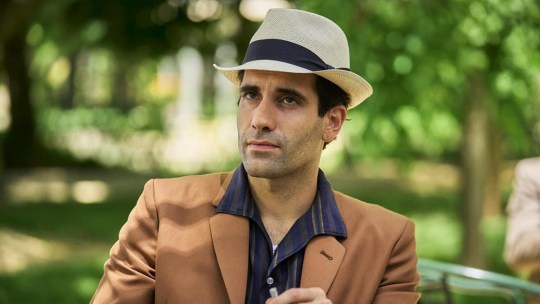



#los pacientes del doctor garcía#1×02#manuel#period dramas#episode 2#tamar novas#stephanie cayo#javier rey#verónica echegui#jon olivares#rtve series
5 notes
·
View notes
Text
Blog#15:
Barcelona and Madrid are rival cities and this can be seen through their soccer clubs. Both represent different ideals and different cultures. Madrid is largely associated with Francoist rule whereas Barcelona is associated with Catalonia and not subjecting themselves to the dictatorship. This is shown through their cultures as well, as Barcelona emulates more anti-centric ideals whereas Madrid followed the norm of Franco and the Spanish government.
0 notes
Text
Law of Amnesty: not what it seems?
On May 30th 2024, the Spanish Government (after a long time of negotiating with Catalan parties) finally approved the Law of Amnesty which will allow some Catalan people who have been repressed for taking part in activism in favour of Catalonia's right to self-determination and referendum to be subjected to an amnesty (meaning they will be pardoned). However, it has been written to be as useless as possible.
Amnesty laws are not unusual around the world, neither in Spain. The most famous one was passed at the end of the fascist dictatorship (1977) to give amnesty to political dissidents who had been sentenced for fighting against the Francoist dictatorship. In the less than 100 years prior, Spain had approved at least 20 amnesties and 70 general pardons, even though some of these amnesties applied to all Spain but left Catalan people out (like General Berenguer's during the dictablanda). In the 2000s, the Spanish Government granted amnesties, most famously the PP party's government led by Aznar granted "hidden amnesties" through mass pardons to 5,948 people, most of which were convicted of corruption and tax evasion. Now, the PP and Aznar are criticizing and recurring the new amnesty for Catalan political prisoners, saying it's illegal and anti-Constitutional. (sources on the previous amnesties)
The new Amnesty Law has gone forward, fruit of a long negotiation process between the Spanish Government and Catalan parties. But the Spanish Governments has the last word on how the law is written, so they made sure to make it very restrictive. It may grant amnesty to those convicted for taking part in Catalonia's self-determination and independence process, but only for some of the crimes they're attributed.
Out of the 4,584 people who have been repressed by the Spanish judicial system for their participation in the Catalan independence movement between 2017 and 2024, the NGO Òmnium explains that only 1,616 of them are elegible for amnesty (source). And even then, amnesty means they have to go to trial again and have the judges agree that the amnesty can be applied to them. The same judges who sentenced them guilty, often twisting the law to do so, like saying that people who acted peacefully can be convicted of crimes that are defined using violence because the violence is metaphorical. And in case anyone still believed in the separation of powers, a group of judges has already created a guide on how to make the Amnesty Law not apply to anything and have sent it to more than 5,000 judges (source).
And, of course, an amnesty is only retroactive. Any "rebellious act" committed after the Law of Amnesty is approved will not be elegible for the amnesty. And, unsurprisingly, on the very day that this law was approved, a Catalan man was already imprisoned for being part of a counter-protest against the Spanish police's rally to homage the Spanish police who brutally beat up Catalan people who were peacefully trying to vote on October 1st 2017, being accused to watch out while another man pushed a policeman (all context here). He is first victim of the new wave of Spanish repression of Catalan people, a wave in a sea that never stops.
Don't get me wrong, the amnesty is good news. These 1,616 people don't deserve the repression they received. It's good that they can be freed from it. But it solves nothing because it doesn't solve the discrimination against Catalans and the fact that Catalans aren't allowed self-determination. We will continue being treated like second-class citizens by Spain, a culture to quietly or loudly exterminate (depending on if it comes from the Spanish "left" or the right, respectively), and we will fight back again. The Spanish Government is saying that this amnesty will put an end to Catalan independentism, but it will not, not until we are equal and free.
18 notes
·
View notes
Text
Events 10.15 (before 1980)
1066 – Following the death of Harold II at the Battle of Hastings, Edgar the Ætheling is proclaimed King of England by the Witan; he is never crowned, and concedes power to William the Conqueror two months later. 1211 – Battle of the Rhyndacus: The Latin emperor Henry of Flanders defeats the Nicaean emperor Theodore I Laskaris. 1529 – The Siege of Vienna ends when Austria routs the invading Ottoman forces, ending its European expansion. 1582 – Adoption of the Gregorian calendar begins, eventually leading to near-universal adoption. 1651 – Qing forces capture the island of Zhoushan. Zhu Yihai, Prince of Lu, resident of the island and regent of the Southern Ming, flees to Kinmen. 1781 – The Battle of Raft Swamp marks the last battle fought in North Carolina during the American Revolutionary War with a Patriot victory. It occurred four days before the British surrender at Yorktown. 1783 – The Montgolfier brothers' hot air balloon makes the first human ascent, piloted by Jean-François Pilâtre de Rozier. 1793 – Queen Marie Antoinette of France is tried and convicted of treason. 1815 – Napoleon begins his exile on Saint Helena in the South Atlantic Ocean. 1864 – American Civil War: The Union garrison of Glasgow, Missouri surrenders to Confederate forces. 1878 – The Edison Electric Light Company begins operation. 1888 – The "From Hell" letter allegedly sent by Jack the Ripper is received by investigators. 1910 – Airship America is launched from New Jersey in the first attempt to cross the Atlantic by a powered aircraft. 1923 – The German Rentenmark is introduced in Germany to counter hyperinflation in the Weimar Republic. 1928 – The airship Graf Zeppelin completes its first trans-Atlantic flight, landing at Lakehurst, New Jersey, United States. 1932 – Tata Airlines (later to become Air India) makes its first flight. 1939 – The New York Municipal Airport (later renamed LaGuardia Airport) is dedicated. 1940 – President Lluís Companys of Catalonia is executed by the Francoist government. 1944 – World War II: Germany replaces the Hungarian government after Hungary announces an armistice with the Soviet Union. 1951 – Mexican chemist Luis E. Miramontes completes the synthesis of norethisterone, the basis of an early oral contraceptive. 1954 – Hurricane Hazel devastates the eastern seaboard of North America, killing 95 and causing massive floods as far north as Toronto. 1956 – FORTRAN, the first modern computer language, is first shared with the coding community. 1965 – Vietnam War: A draft card is burned during an anti-war rally by the Catholic Worker Movement, resulting in the first arrest under a new law. 1966 – The Black Panther Party is created by Huey P. Newton and Bobby Seale. 1970 – During the construction of Australia's West Gate Bridge, a span of the bridge falls and kills 35 workers. The incident is the country's worst industrial accident to this day. 1979 – Supporters of the Malta Labour Party ransack and destroy the Times of Malta building and other locations associated with the Nationalist Party. 1979 – A coup d'état in El Salvador overthrows President Carlos Humberto Romero and begins the 12 year-long Salvadoran Civil War.
0 notes
Text
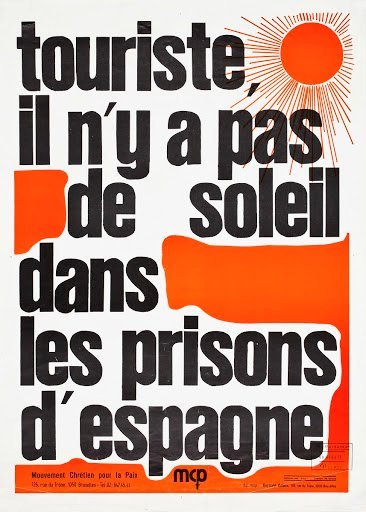
French 1974 anti-Francoist poster ....
"Tourist, there's no sun in the prisons of Spain".
1 note
·
View note
Photo









- ¿Por qué no me ha obedecido? le hubiera sido mucho mas fácil. - Sí, pero es que obedecer por obedecer, así sin pensar, solo lo puede hacer gente como usted, capitán.
#pan's labyrinth#el laberinto del fauno#guillermo del toro#Álex Angulo#ofelia#Capitán Vidal#Sergi López#Mercedes#Doctor Ferreiro#Ivana Baquero#Maribel Verdú#Fauno#el hombre pálido#Doug Jones#Princess Moanna#Faun#the Pale Man#anti-Francoist#Pans Labyrinth#españa#franco#Bleiches Monster#Dr#Ferreiro
39 notes
·
View notes
Note
"Crossbreeding" guy is homophobic, transphobic, anti vaxx, and Catholic from a quick glance at their Tumblr page so somehow I'm not at all surprised by their absolutely fucking horrible take.
They've got the francoist color scheme too.
219 notes
·
View notes
Text
Empar Pineda i Erdozia
• Empar is a Spanish feminist activist born in Hernani, Gipuzkoa in 1944.
• She was enrolled in a German nun's school, where she was required to learn English.
• As there was no public university in the Basque Country, she moved to Madrid, where her sister lived.
• She participated in the anti-Francoist student movement and was banned from enrolling at the Universities of Madrid and Barcelona. She ended up enrolling at the University of Salamanca in 1964, and a little later at the University of Oviedo, where she graduated in Romance philology.
• She returned to Madrid, where she began teaching Language and Literature while continuing her membership in left-wing organizations.
• An anti-Francoist militant, she was arrested by the authorities and spent some time in Martutene Prison.
•In the 1970s, during the transition to democracy, she moved to Barcelona. There she was the leader of the Communist Movement of Catalonia.
•In 1985 she was interviewed in the magazine Interviú with the headline "I am a lesbian just because ", to demand an end to the repression of homosexual women.
• In 1980 she was co-founder of the Lesbian Feminist Collective of Madrid and participated in the creation of the Right to Abortion Commission.
• In 2008 she received the Creu de Sant Jordi for "her dedication sustained for so many years in defense of women's rights, from the action – as an active member of various organizations – and reflection – as a co-author of several volumes, including 'El feminismo que existe'."
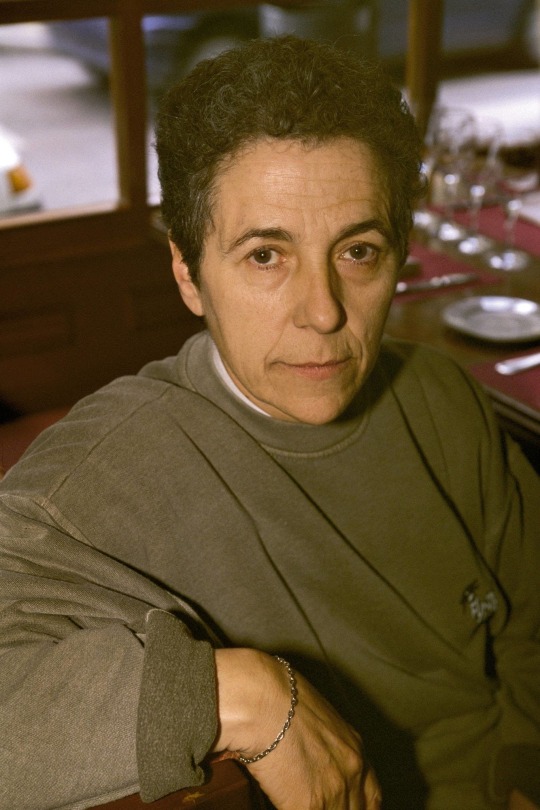
5 notes
·
View notes
Photo

Radical Spanish novelist, newspaper columnist and cultural commentator determined to tell the truth about the Franco era
Almudena Grandes, who has died of cancer aged 61, achieved the rare feat of being both a very popular and a highly serious writer. A bestselling novelist, newspaper columnist, radio commentator and outspoken leftwinger in her native Spain, she became the main literary voice of a mass movement to recover her country’s historical memory.
The government of José María Aznar in the early 2000s encouraged rightwing revisionism that falsified the history of the Spanish civil war and prettified Franco. In response, anti-Francoists and their descendants began to speak out against the murders, torture and imprisonments of the dictatorship. Even today, disgracefully, over 114,000 victims of Franco still lie in unmarked graves.
“Spain is the only democracy in Europe,” Grandes wrote, “that turns its back on its own anti-fascist tradition.” She embarked on the ambitious project of a series of six novels with the title Episodios de una Guerra Interminable (Episodes in an Endless War), to record the forgotten struggles and suffering of anti-Franco fighters, especially women. Five of the six have been published, selling some 1.3m copies between them.
The first, Inés y la Alegría (Inés and Happiness), came out in 2010. It is the story of the communist invasion of the Vall d’Aran in the Pyrenees in 1944, told not in heroic terms of military prowess, but mainly through Inés, cook for the partisans. The fourth, Los Pacientes del Dr García (Dr García’s Patients, 2017) won the Spanish government’s national narrative prize.
Grandes’ model was Benito Pérez Galdós (1843-1920), Spain’s pre-eminent realist novelist, whose Episodios Nacionales (National Episodes) covered most of the 19th century. Like Galdós, Grandes focused on the lives and feelings of ordinary people trampled by history. Both were writing historical fiction in order to change the present and shape the future.
She also appeared regularly on radio programmes and in 2008 took over the Monday back-page column that Manuel Vázquez Montalbán had made famous in the newspaper El País.
She was a supporter of the political coalition United Left and took part in election campaigns, movements against male violence and for women’s rights, and campaigns against repressive legislation.
One of four children of Manuel Grandes, who ran a plumbing business, and his wife, Benita Hernández, Almudena was born and brought up in Madrid. She told how she was a fat child who never got a part in the Christmas play. Her intimate revenge was in reading and dreaming of becoming a writer. She studied geography and history at Madrid’s main university, the Complutense – to please her parents, she said, though she would have preferred Latin. Belonging to the generation that came of age in the new post-1977 democracy, she plunged into the Madrid Movida, the youth explosion of freedom following the grey, repressed years of the dictatorship.
After graduation she worked as a writer of encyclopedia texts. The research and time limits gave her, she said, the discipline to write. Her first completed book was the taboo-breaking Las Edades de Lulú (1989, translated as The Ages of Lulu, 2005), which won the Sonrisa Vertical (Vertical Smile) prize for erotic fiction. Not just literary porn, the novel explored the difficulties and joys for women in the new Spain, though many feminists saw it as a fantasy for men. Its unexpected success (more than 1m copies sold in 20 languages) gave Grandes the confidence and cash to write full-time.
Her 1990s novels were mainly stories of young women finding their feet in the whirlwind of 80s Madrid. Los Aires Difíciles (2002, translated as The Wind From the East, 2006) is a saga of family conflict and secrets revealed, set mainly in Rota, on Andalusia’s Atlantic coast, where Grandes herself spent her summers for 30 years. Like most of her novels, it is long, packed with stories and characters and is almost a typical beach-read blockbuster; but it is slower, with deeper psychology, more like a fine 19th-century novel. Grandes entertained with powerful stories; and also wanted her readers to think.
El Corazón Helado (2007; translated as The Frozen Heart, 2010) deals with a family shattered and split by the civil war. It opens with a young woman whom no one knows appearing at the funeral of a wealthy man. This device borrowed from sensationalist novels at once pulls in the reader. Like subsequent novels, it is a sweeping epic, covering decades of history and, in the case of The Frozen Heart, geography from Russia in wartime to contemporary Madrid.
Six of her 13 novels have been made into films, including The Ages of Lulu, which was directed by Bigas Luna with Javier Bardem in his first starring role.
Grandes is survived by her husband, the poet Luis García Montero, whom she married in 1996, their daughter Elisa, her son Mauro, from a previous relationship, and her stepdaughter, Irene.
🔔 María de la Almudena Grandes Hernández, novelist, born 7 May 1960; died 27 November 2021
Daily inspiration. Discover more photos at http://justforbooks.tumblr.com
18 notes
·
View notes